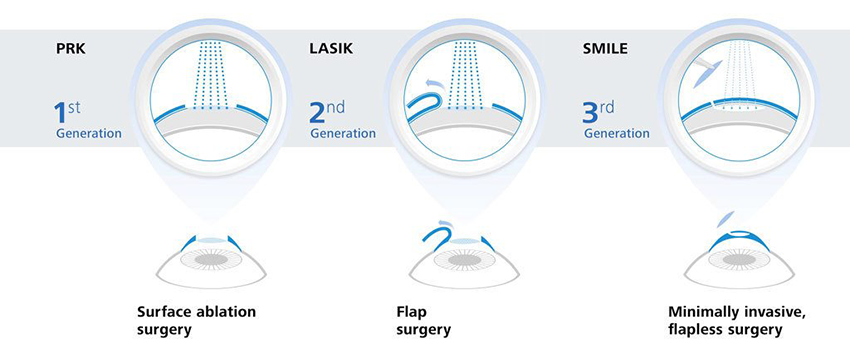With the introduction of the VisuMax (Zeiss) femtosecond laser platform in 2016, a procedure known as small incision lenticule extraction (SMILE) became available in the U.S. as the latest advancement in refractive surgery.
With each generational change from PRK to LASIK to SMILE, the differences with SMILE became clear.
SMILE obviates the need for excimer lasers. The VisuMax femtosecond laser is used for tunnel and lenticule creation, and microforceps remove the lenticule without the need to debride corneal epithelium or to create a flap.

The Pros
There is a presumed biomechanical advantage in corneal stability post-surgery with SMILE compared with LASIK, allowing for a reduced residual bed thickness requirement and a lower potential risk for corneal ectasia in the future. (See below for more information.)
SMILE has shown a lower prevalence of dry eye symptoms after six months when compared with LASIK, with less disruption of corneal nerve fibers.
Regarding post-operative restrictions, SMILE patients are generally instructed to refrain from strenuous activity for about three days, whereas LASIK and PRK patients are to refrain from such activities for about a month. This difference could prompt some patients to choose SMILE.
The Cons
Despite these advantages, SMILE has several drawbacks compared to LASIK. Visual recovery with SMILE can take up to a few days, whereas LASIK patients may experience instant recovery.
SMILE isn’t able to treat higher order aberrations (HOAs) and can potentially exacerbate pre-existing ones.. LASIK has the advantage of utilizing Wavefront optimized or guided technology with the excimer laser to treat these HOAs, which allows for greater customization of treatment for the patient’s unique corneal aberrations.
One study in the Journal of Refractive Surgery showed more predictable outcomes, better aberrometric control, better preservation of visual quality and a significantly higher percentage of patients achieving 20/20 or better visual acuity in LASIK compared to SMILE.
Indications
Myopic correction with SMILE is indicated for myopia of -1.00 to -10.00 D with or without astigmatism of ≤ –3.00 D and a maximum total prescription (spherical equivalent) of < 10D, according to the Food and Drug Administration. Unlike LASIK, SMILE isn’t approved for hyperopia in the U.S. at this time, but this indication is currently under investigation in clinical trials and may become available in the future.
Figure 2: SMILE vs LASIK Comparisons
| |
SMILE |
FS - LASIK |
| Average Cost 2019* |
$2,361 per eye |
$2,246 per eye |
| Approval Year in US |
2016 |
1999 |
| More widely available |
|
X |
| Indicated in the US for hyperopia |
|
X |
| Incision |
2-3 mm |
20 mm |
| Femtosecond? |
X |
X |
| Excimer? |
|
X |
| Favorable corneal sensation/TBUT2 |
X |
|
| Treat HOAs** |
|
X |
*Market Scope U.S. Refractive Surveys (2019)
**Higher order aberrations, FS - LASIK = femtosecond LASIK |
Differing Contraindications
The same general contraindications to LASIK exist for SMILE. In LASIK, mild dry eye disease is considered a relative contraindication, but in SMILE this is relaxed to moderate dry eye.
SMILE allows a greater amount of stromal tissue to be removed with a residual bed thickness (RBT) ≧ 250 microns, whereas RBT in LASIK should be ≧ 300 microns. In LASIK, significant corneal scarring is a contraindication, but in SMILE, it is more restrictive to mild corneal scarring as an absolute contraindication, according to a 2018 article in the Current Opinion in Ophthalmology.
Patients who are candidates for SMILE should also be good candidates for LASIK. Surgeons often request consent from patients for both procedures in the event the SMILE procedure needs to be aborted (i.e., suction loss), as LASIK can subsequently be performed as a rescue procedure.
Future Direction
Many refractive surgeons are waiting on more clinical data to become available before they adopt SMILE into their practice. In an article from the Journal of Refractive Surgery, Mounir A. Khalifa, MD, PhD, and his fellow researchers discuss the exciting prospect of developing a wavefront-guided SMILE technique.
As new technologies are developed for SMILE and more clinical data arrive, the disadvantages of the procedure compared to LASIK may start to diminish and more refractive surgeons may adopt SMILE into their practices.
About the authors: Rob Melendez, MD, MBA, is CEO and founder of Juliette Eye Institute, a cataract and refractive laser center in Albuquerque, N.M. He has served in several Academy leadership positions, from YO committee chair to secretary for online education (EyeWiki and the ONE® Network). He is also chair of the Ophthalmology Busines Summit, which will be held virtually in May 2021.